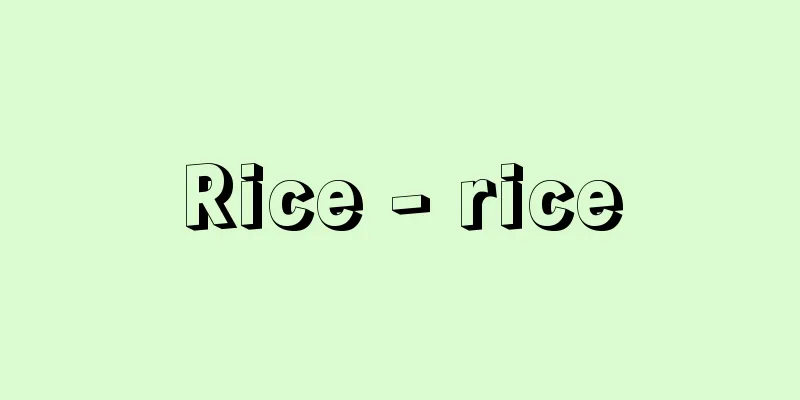Rice - rice

|
The term refers to the seeds (caryophylla) of plants of the genus Oryza, which is part of the Poaceae family (APG classification: Poaceae). The total production of rice in the world exceeds 600 million tons per year as unhulled rice, and it is said to be one of the world's three major grains along with wheat and corn. Nearly 90% of rice is produced in Asian countries, and most of it is consumed in Asia. It goes without saying that rice is an important staple food for the Japanese, and is also an important food for more than half of the world's population, including India, China, Southeast Asian countries, and the Far East. [Fuwa Eiji] Structure and ingredientsBrown rice is rice that has had the husk removed from it (hulled rice), and is made up of the germ, endosperm, and pericarp. By weight, brown rice is 5-6% bran layer (mainly the pericarp and aleurone layer), 2-3% germ, and 90-92% endosperm compared to the whole grain. Therefore, white rice (polished rice), which has had the germ and bran layer removed from brown rice by polishing, is mainly the endosperm portion. Seventy percent polished rice is rice that has had 70% of the amount removed by fully polished rice removed, and has a polishing yield of 93-94%. Polished rice that has a germ retention rate of 80% or more is called "germ polished rice." The main component of the endosperm, and therefore the main component of white rice, is starch, which accounts for about 90% of the dry weight. White rice contains about 6.8% protein by dry weight. It also contains little fat, minerals, vitamins, or dietary fiber. This is because most of the components other than starch are contained in the germ and bran layer and are removed during the polishing process. [Fuwa Eiji] Spread to JapanIn addition to rice, the Gramineae family includes many important food crops for humans, such as wheat, barley, and corn. Currently, the Oryza genus is classified into 22 species, of which two are cultivated. The sativa species , Oryza sativa L., is said to have originated in the Himalayan foothills in the Assam and Yunnan regions of Southeast Asia between 7000 and 6000 BC, and is currently cultivated in almost all rice-growing regions around the world. In contrast, the glaberrima species , Oryza glaberrima Steud., known as African rice, is native to Africa and is only cultivated in a small part of West Africa. However, it is believed that the ancestors of these two species are connected somewhere. It is almost certain that the Sativa species was domesticated from the wild rice species Perennis, but since this wild rice does not exist in Japan, it is not believed that the Sativa species was domesticated in Japan, but was introduced from abroad. There are at least three routes by which rice was introduced to Japan: via the Korean Peninsula, from the south of the Yangtze River, and the "Sea Road" (from the south), all of which first landed in Kyushu from the north, west or south, and then moved eastward. It is said to have been introduced during the early Yayoi period or the late Jomon period, but rice cultivation had already existed in various parts of the Asian continent for nearly several thousand years before that. Therefore, it is believed that rice seeds were introduced along with the rice paddy cultivation technology, which involves building ridges to utilize water, and the rice paddy farming culture. [Fuwa Eiji] kindsJapanese and Indian typesThe world's sativa species, and therefore the world's rice, can be broadly divided into Japanese type (japonica) and Indian type (indica). These two types of rice have many differences in morphology, ecology, genetics, physiology, and other characteristics. There is no single characteristic that can be used to clearly classify the two groups, but by creating a discriminant function by combining the phenolic reaction of the grain, the resistance of young plants to potassium chlorate and low temperatures, the length of the seed hairs, etc., and using the value, it is possible to distinguish between the two groups with relatively high accuracy. In general, the length-to-width ratio of Japanese-type rice is 1.7 to 1.8, while most Indian-type rice is around 2.5. Rice with this ratio of 2 or less looks round. Most of the so-called domestic rice and foreign rice correspond to Japanese type and Indian type, respectively. Rice cooked with Japanese-type rice is sticky, but foreign rice cooked under the same conditions is less sticky and dry. This is thought to be due to the difference in the starch properties of the two and the differences in the texture and structure of the rice grains. The Indian type is widely eaten around the world, with only Japanese people and a few others preferring the Japanese type. [Fuwa Eiji] Paddy rice and upland riceRice grown in paddy fields is called "wet rice" (sui-tou) and rice grown in fields is called "upland rice" (riku-tou). The wet rice and upland rice cultivated in Japan have many differences in characteristics and seem to be different species, but these two types of rice are considered to be continuous variations. The yield per unit area is higher for wet rice, and the area planted with upland rice in Japan is much smaller than that of wet rice. [Fuwa Eiji] Non-glutinous rice and glutinous riceThere are two types of rice: non-glutinous rice, which is used for eating, and glutinous rice, which is used for making mochi (rice cakes) or red rice. The main difference between the two is the starch that is the main component. In other words, the starch of non-glutinous rice is made up of about 20% amylose, a straight-chain component, and about 80% amylopectin, a branched-chain component, whereas the starch of glutinous rice contains almost no amylose and is mostly amylopectin. Therefore, non-glutinous rice and glutinous rice can be easily distinguished by the iodine-starch color reaction of the endosperm. In other words, non-glutinous rice stains blue in an iodine/potassium iodine solution, whereas glutinous rice is red to reddish brown. The sticky texture of glutinous grains such as glutinous rice, glutinous millet, and glutinous foxtail millet is a characteristic that is favored by people living in areas with a culture of evergreen broad-leaved forests. [Fuwa Eiji] Varieties and brandsJapanese rice has undergone repeated improvements to reach the present day. As a result, there are many varieties (or cultivars). As the supply and demand of rice has eased from a shortage, consumers' preferences have become more inclined to seek high-quality, tasty rice, and the area planted for varieties with excellent taste, such as Koshihikari, has increased, replacing high-yield varieties. However, Koshihikari and Sasanishiki, which are extremely popular for their taste, are both susceptible to rice blast disease, have weak culms, and are prone to lodging under high fertilizer conditions. Sasanishiki peaked in 1990 (Heisei 2), and the area planted there has been decreasing ever since. In the 2017 rice crop, 53.9% of the total planted area for non-glutinous rice was occupied by the top three varieties, Koshihikari, Hitomebore, and Hinohikari, followed by Akitakomachi, Nanatsuboshi, Haenuki, and Kinuhikari. [Fuwa Eiji] Hard and soft riceHard rice is rice with low moisture content that does not easily crumble, while soft rice is rice with high moisture content that crumbles easily. The same variety can be hard or soft depending on the soil and other growing conditions. In western Japan, people generally prefer soft rice varieties such as Koshihikari for their taste, while in eastern Japan, hard rice is often preferred. [Fuwa Eiji] Perfect rice and imperfect riceRice that is completely ripened and fully displays the grain shape characteristic of that variety is called perfect rice. In contrast, rice that is not perfect, that has some abnormal defect in the shape, size, color, etc., is called imperfect rice. Known types of imperfect rice include green rice, cracked rice, cut rice, twisted rice, tapered rice, brown rice (burnt rice), milky white rice, dead rice, semi-dead rice, shina, no-embryo rice, double embryo rice, and twin rice. White-bellied rice and white-core rice are considered to be perfect rice. [Fuwa Eiji] Rationed rice (government rice) and independently distributed riceDuring World War II, the Food Control Law of 1942 (Showa 17) put in place a rice rationing system, and the Price Control Order of 1946 regulated the price of rationed rice until 1969 (Showa 44). However, in response to an easing of rice supply and demand and consumer preferences for high-quality rice, the government launched a system of independently distributed rice in addition to rationed rice (government rice) from the 1969 harvest. Independently distributed rice allows freedom in price, and rice wholesalers are free to purchase rice from designated collectors, so according to the principle of price formation, it is inevitable that high-quality rice will be quite expensive. In 1995, the Food Control Law was replaced by the Law Concerning Stabilization of Supply and Demand and Prices of Staple Foodstuffs (commonly known as the Food Law). Producers were no longer required to sell rice to the government, illegal free rice was officially recognized as unplanned distribution rice, and independently distributed rice, along with government rice, became planned distribution rice. As a result, the price of government rice also began to reflect supply and demand. Furthermore, in 2004, the Food Stuffs Act was amended so that the distinction between planned and unplanned distribution rice was eliminated, and only the distinction between privately distributed rice and government rice remained. [Fuwa Eiji] Quality InspectionIn the past, both rationed rice and independently distributed rice were required to undergo government-designated inspection under the Agricultural Products Inspection Act. Even after the planned distribution system was introduced in 1995, inspection was still mandatory for planned distribution rice, but with the abolition of the planned distribution system in 2004, inspection became voluntary for all rice. The inspection body was formerly the national government, but with the revision of the Agricultural Products Inspection Act in 2000, this role was transferred to private, registered inspection organizations. Brown rice is graded into grades one through three or below based on inspection standards for volume weight (grams per liter of rice), % whole grains (% of normal rice grains excluding damaged, dead and immature grains), % moisture, characteristics (thickness or thinness of the bran layer of the rice grain, hardness or softness of the rice quality, uniformity of the grain, grain shape, luster, unevenness of the skin, degree of white belly, etc., but as these are not easily measurable, the degree of grade is shown by comparison with a standard product, i.e., an actual sample), % damaged grains (% of rice grains that have been damaged or damaged), % dead rice (% of rice grains that are not full and have a powdery texture), % foreign grains (% of grains other than brown rice), and % foreign matter (stones, sand, etc.). This brown rice standard mainly indicates morphological and physical quality, and the items of volume weight, whole grains and damaged grains are indicators of milling yield and moisture is an indicator of storage quality, but it does not include any items directly related to taste. In addition, the JAS Law (Law Concerning Standardization and Proper Labeling of Agricultural and Forestry Products) made it mandatory to label the quality of rice sold in containers or packages in April 2001. The contents of the labeling are the following five items as a whole: (1) name (brown rice, polished glutinous rice, polished non-glutinous rice or polished rice, polished rice with germ), (2) raw brown rice (place of origin, variety, year of harvest, proportion used), (3) content, (4) date of polishing, and (5) seller (name, address, telephone number). [Fuwa Eiji] Black riceBefore the Food Control Law was abolished in 1995, selling rice that had not passed government inspection was illegal, i.e., black market rice (irregular rice). During and after World War II, when food was scarce, consumers (city dwellers) went to farms to buy black market rice. From around 1967, there were successive bumper harvests, and the supply and demand of rice eased from the shortage. Consumers were not satisfied with the taste of rationed rice, and they began to seek better quality rice with better taste. In response to this, carriers began to travel from rural areas to cities to sell delicious, high-quality, branded black market rice. Eventually, with the abolition of the Price Control Law and the establishment of independent rice distribution, black market rice seemed to have disappeared. However, it was widely known that black market rice was being manipulated by organized merchants with huge funds. At the time, the price of black market rice offered to farmers was lower than that of independently distributed branded rice, but the appeal for farmers was that they could sell it from their front yard, they could pay in cash, and there was no tax involved. In 1987, a specially cultivated rice system was established as an exceptional measure, whereby farmers and consumers traded directly. Furthermore, under the Food Control Law that came into force in November 1995, rice that fell outside of the regular distribution route, including black market rice that had been called "free rice" under the Food Control Law, was designated "unplanned distribution rice," and distribution was permitted if the sales volume was reported to the government. In the revised Food Control Law that came into force in 2004, unplanned distribution rice, together with independently distributed rice, came to be called "privately distributed rice." [Fuwa Eiji] New and old riceRice that is more than one year old is called old rice, and when new rice is produced, rice that is older than that is called old rice. Rice that is more than two years old is called very old rice. The degree to which rice becomes old varies depending on the storage method, temperature, humidity, and storage period, and therefore the degree of deterioration in taste. In Japan, except for storing rice loosely in the silos of country elevators, most rice is stored as brown rice, and under normal storage conditions other than low-temperature storage (15°C or less, relative humidity 70-80%) or semi-low-temperature warehouses (always 20°C or less), brown rice generally loses taste suddenly after the rainy season of the following year and summer begins. It is natural that rice becomes old and loses taste quickly under high temperatures and humidity, but under these conditions, mold and insects will grow on the rice, making it taste even worse. Also, fumigation and disinfection with chemicals to prevent insects and mold can cause the taste to deteriorate even further. Storing rice in unhulled form is less susceptible to mold and insects than storing it in brown rice form, and the rice is less likely to breathe or come into contact with air, so the taste is less likely to deteriorate. It is also known that storing polished rice causes the taste to deteriorate more quickly than storing brown rice. [Fuwa Eiji] Sake-brewing rice (sake rice)In principle, any type of rice can be used as the raw material for sake brewing. However, the rice used in sake brewing, especially the base rice used to make rice koji (koji), must be more highly polished (80% or less, sometimes 60% to 50%) than regular edible non-glutinous rice (90% to 92%). Therefore, rice that is less likely to crumble even after polishing and that is well suited to the incorporation of koji mold is specified as suitable for sake brewing (brewing base rice). These are generally large-grained varieties with a lot of white belly or white core in the abdomen of the grain. Namely, Yamada Nishiki (Hyogo Prefecture, Okayama Prefecture), Omachi (Okayama Prefecture), and Gohyakumangoku (Niigata Prefecture) are famous varieties for sake brewing. However, as sake brewing becomes more mechanized, varieties suitable for mechanically made koji (seikiku) are being developed. [Fuwa Eiji] Red riceRed rice is rice that contains red pigments in the seed coat on the surface of the brown rice. The grain color ranges from light brown to almost blackish purple. White rice, which is usually transparent or slightly white, can be a mutation of red rice. Farmers dislike red rice because it lowers the quality of the rice. There are two types of red rice currently seen in Japan: Japanese type and Indian type. Japanese type red rice is thought to have been introduced to ancient Kyushu at almost the same time as white rice grains, and there are glutinous and non-glutinous types. On the other hand, Indian type red rice originated much later than Japanese type red rice, originating from Champa rice (Indian type rice that was introduced to southern China from Champa in Vietnam) that was introduced from central China between the late 11th century and the 14th century, and is also called Daitōmai, Tei-tō, and Tōboshi. Non-glutinous rice is the norm, but glutinous varieties also exist. In Tsushima, Iki, Goto and other islands, rice planting using Japanese red rice varieties is still performed as a Shinto ritual, and red rice is served afterwards. There is a theory that the modern red rice dish originates from this red rice dish. [Fuwa Eiji] Deteriorated riceVarious microorganisms can grow on rice, causing spoiled rice (disease rice). When molds of the Penicillium genus grow on rice, they produce a yellow or reddish-red substance that discolors the grains, and this spoiled rice is called yellowed rice. This phenomenon has been known in Japan for a long time, although only to a very small extent. In particular, during the food shortages following World War II, harmful Penicillium bacteria that produce liver poisons were isolated from some of the rice imported, which became a major topic of discussion, especially in 1954-1955. [Fuwa Eiji] Fragrant riceA variety of rice with a particularly strong brown rice fragrance is called fragrant rice. Although the smell is not pleasant, if you mix a small amount of it (about one cup per 1 sho of rice) with regular rice and cook it, it will give off the delicious aroma of newly harvested rice. It is grown by a small number of farmers across the country and is blended into sushi rice and other dishes. It is also grown not only in Japan but also in Southeast Asia, America, and other places. [Fuwa Eiji] Hybrid RiceIt means a first generation hybrid variety ( F1 variety) of rice, and its purpose is to improve yield by utilizing hybrid vigor. When cross-fertilized crops such as corn are artificially self-fertilized, the plant height decreases, the yield drops significantly, and the vitality is reduced. This phenomenon is called self-fertilization weakness. The hybrid F1 between these self-fertilized lines has stronger vitality than the one before self-fertilization. This phenomenon is called heterosis. Hybrid vigor is not fixed, and when self-fertilized, it becomes weak again. Therefore, it appears only in F1 and degenerates in the second generation ( F2 ) and after. F1 varieties have a long history in corn, and have achieved remarkable results. However, there are various difficulties in putting F1 varieties of self-fertilized rice and wheat to practical use. Since the People's Republic of China developed the world's first practical hybrid rice variety in 1974, many varieties have been developed and are in the practical stage, but they have not yet been successfully put to practical use in countries other than China. In Japan, the practical application of hybrid rice using cytoplasmic male sterility and fertility restorer lines is eagerly awaited. In 1984 (Showa 59), the Ministry of Agriculture, Forestry and Fisheries' Hokuriku Agricultural Experiment Station developed "Hokuriku Kou No. 1," with Fujisaka No. 5 rice as the mother and a cross between Reimei and a foreign rice as the father, and an application has been submitted for registration as a new variety under the Seed and Seedlings Act. The yield is high at 7.9 tons per hectare, more than 10% higher than Akihikari, the previous top-yielding variety. However, the long stems and heavy ears make it prone to lodging, and it is still unclear whether it will be practical. [Fuwa Eiji] nutritionThe total energy content of 100 grams of polished rice (roughly equivalent to two rice bowls of rice) is 356 kcal. For example, if you eat four bowls of rice twice a day, about 30% of your daily intake of 2,500 kcal will come from rice. The majority of this energy (more than 80%) comes from carbohydrates, mainly starch, which is easily digestible. Rice contains about 7 grams of protein, and four bowls of rice provide one-fifth of the daily protein requirement of about 70 grams. Rice protein is one of the best among plant-based foods. The combination of rice, soybeans, and fish in the traditional Japanese diet complement each other in terms of protein, making it almost ideal in terms of how they are consumed. Brown rice contains a significant amount of B vitamins such as vitamins B1 and B2 , niacin, and dietary fiber, but since most of these are found in the germ and bran layer, you cannot expect much from polished rice. [Fuwa Eiji] World rice production and rice-eating peoplesWorld rice production (unhulled rice) was just over 500 million tons in the 1990s, but by the 2000s it had exceeded 600 million tons. The major producing countries, in descending order of production, are China, India, Indonesia, Bangladesh, Vietnam, Myanmar, Thailand, the Philippines, Brazil, Pakistan, the United States, Cambodia, and Japan. Trade volume accounts for around 5% of total production, with the main exporting countries being India, Vietnam, Thailand, Myanmar, etc., and the main importing countries being China, Indonesia, the Philippines, etc. The majority of rice produced in the world is the Indian type, and production of the Japanese type is very small, mainly in Japan, South Korea, parts of China, and parts of Myanmar. The international rice price is set based on the export price (BOT published price) announced by the Board of Trade of Thailand (BOT), and fluctuates from year to year. In 1980, the BOT published price was over 400 US dollars per ton of polished non-glutinous rice, but it has since declined to around 300 US dollars between 2004 and 2006. This is at most 30 yen per kilogram, about one-ninth of the price of rice in Japan (approximately 16,000 yen per 60 kilograms). However, since October 2007, due to export restrictions in Vietnam, India, China, and other countries, the international rice price has risen sharply. After hitting a record high of 1,038 US dollars per ton on May 21, 2008, it has fallen, and since November of the same year, it has been at around 600 US dollars per ton. It has continued to fall since then, to around 380 US dollars from 2016 to 2017. If we classify the way in which humans consume nutrients on Earth into several types, there are four main types: wheat, rice-dominant (rice-eating), miscellaneous grains, and root vegetable-dominant, with the first two being particularly important. Of these, the rice-eating type forms the largest population in the world, and is found in southern India, the Indochina Peninsula, Southeast Asian countries, southern China, North Korea, South Korea, and Japan. On the other hand, wheat-eating is widespread in North and South America, Europe, Russia, and other areas. In other words, it can be said that these are determined by the growth suitability of each plant. However, rice has many advantages compared to other miscellaneous grains, such as a high yield, stable yield, good taste, and large grains that are easy to polish and cook. In addition, rice can be grown continuously, and unlike field crops such as corn and wheat, there is also the advantage that there is little surface soil erosion in paddy fields, so there is a high possibility that rice production will increase worldwide in the future. In fact, even in places where wheat was the main food, there are many cases where people have switched to rice cultivation and started eating rice where rice cultivation is possible. Japan is an extremely rare exception, as it is well suited to rice cultivation and has traditionally been the staple food, but the shift in preference to wheat is now apparent. [Eiji Fuwa and Masao Yokoo] History and Present of Rice EatingOrigin and distribution of rice consumptionBotanically, there are two types of rice. One is the common rice, which began to be cultivated in the mountainous regions of southern China. The other is the glaberrima species, which was domesticated in the middle Niger River basin in West Africa and is cultivated in a large area of central Africa. However, the glaberrima species remained as one element of the millet farming culture of the region and did not develop into a unique rice-eating culture. Ordinary rice, native to East Asia, gave rise to a distinctive rice-growing culture in East Asia that corresponds to the wheat-growing culture that originated in West Asia, and created a unique rice-eating culture. This culture extends to Japan, Korea, central and southern China, Southeast Asia (Sulawesi at the eastern end), Myanmar in the west, the Assam region of India, Bhutan in the Himalayas, Sikkim, and Nepal. Although rice is cultivated in the vast rice-growing region of India, Bangladesh, the rice-growing culture is somewhat different, and it is thought that the rice-eating culture there is also somewhat different. It is believed that rice has been eaten since before it was domesticated. It was collected as wild rice. Various wild rice species are distributed in tropical wetlands in Asia, Africa, and Central America, and among them, common rice in Asia and the Glaberrima species in Africa have been domesticated, while wild rice in Central America has not been used. Archaeologically, rice has been excavated from the Nong Noktar ruins in northeastern Thailand, but it is not clear whether it was wild collected or cultivated. It is believed to date to around 3500 BC. Very old rice-growing cultures have been excavated in the Yangtze River region of China recently, but the chronology of rice-growing cultures has not yet been established. Based on the data available, the history of rice as food dates back to about 6000 years ago. [Sasuke Nakao] Eating rice in historical timesMany earthenware steamers have been excavated from Japan's Kofun period, and they are believed to have been used to cook sticky rice. In the Nara and Heian periods, steamed sticky rice was called kowaii and was considered the official meal, but there was also katakayu (hard rice porridge) and shirukayu (soup porridge) made with non-glutinous rice, and modern Japanese cooked rice is derived from kowaii. In China, from the Spring and Autumn Period to the Warring States Period and the Han Dynasty, sticky rice was the standard way of cooking rice in the Yellow River region. Even today, sticky rice is favored among Thai people, and sticky rice is a regular food among some Thai people in southern China, as well as Thai people in Laos and nearby areas. Cooking non-glutinous rice was difficult in the days when there were no metal pots and only earthenware. Earthenware is fine for making porridge, but when cooking rice, the earthenware is prone to burning and is often damaged. For this reason, various methods of cooking rice were devised in different regions. In Indonesia, rice was boiled in a bamboo sieve placed inside the earthenware, or in a large amount of water, the water was removed when the rice was half-cooked, and then the rice was steamed over low heat. This method was called the yudori method, and was customary in Korea, China, Southeast Asia, and India. The current standard way of cooking rice in Japan is to cook it all the way through in a set amount of water, and is called the takiboshi method. The takiboshi method is also found in cities in Southeast Asia and India, and is now spreading to rural areas as well. The practice of eating rice flour is seen subtly throughout all rice-eating cultures. It is based on the wet milling method, in which white rice is soaked in water overnight to absorb the water, and then milled in a stone mortar to produce wet lumps. This is called "shitogi" and is seen in Japan, Korea, China, the Philippines, Sri Lanka, and other regions. In Japan, shitogi is offered as is in religious ceremonies, while in other countries it is further cooked and processed before being eaten. In the Philippines, steamed bread is made from shitogi, and in Sri Lanka, noodle-like products and chapati-like foods are made. In Southeast Asia, sweets are often made from shitogi. [Sasuke Nakao] Current rice dietIn rice-eating areas of East Asia, rice is the staple food, and a meal system has been established in which side dishes are also eaten with it. In this case, pure white, light-flavored rice is chosen, and detailed preferences have been developed regarding the quality of the rice. Starting from mid-west India and Pakistan, and further west in Iran, Western Asia, and Europe, rice is second only to wheat in importance, but the basic cooking methods are different. The original form was pulao, which is washed rice fried in oil and cooked with salt. There are also high-quality pulaos that contain spices, dried fruit, and meat. The name pulao spread to Europe and became pilaf. Paella in the Iberian Peninsula is of this type. Also, in Italy there is a rice soup similar to rice porridge called risotto. In Europe, plain rice and rice dishes have recently begun to be served on plates, but they have not become the main dish of a meal. Currently, it is estimated that 51% of the world's population eats rice, with most of that number living in Asia. [Sasuke Nakao] America and the JapaneseJapanese History and Rice Cultivationになったんです。 English: The first thing you can do is to find the best one to do.になったんです。 English: The first thing you can do is to find the best one to do. Furthermore, the land tax reforms that took place during the establishment of a modern state after the Meiji Restoration revealed the divisions between government, public and private land across the country, and owners were allowed to pay land taxes. In other words, the land was largely based on rice, and the majority of the land tax was paid in cash. [Fuwa Eiji] Japanese people's lives and the USRice farming is carried out in paddy fields adjacent to small plots, with a huge amount of work in the appropriate periods such as rice planting, weed removal, and harvesting, and with the management of the water connecting the mutual rice fields. Therefore, a strong, horizontal community, or rural community, has been formed, targeting rice fields in certain regions. It is said that urban and industrial communities dominate these days, but today more than a third of the population is still settled in rural areas, and considering that a significant portion of urban residents are also from rural areas, the impact of rural communities on Japanese society is large. Furthermore, expectations for harvesting in paddy rice farming, the strictness of labor, and the fear of disasters caused by weather and pests have led to the Japanese faith, and the development of festivals and entertainment. になったんです。 English: The first thing you can do is to find the best one to do. In the Showa era, rice, which tends to be shortages in the wartime regime, gradually became more and more state-controlled, and in 1942 (Showa 17), a food control system was established in which the entire state directly manages all of its major foods, and the basic principle of rice was based on the direct government's management, but in 1995 (Heisei 7), the system was changed significantly with the enactment of the Food Act. [Fuwa Eiji] Myths and legendsThe Kojiki and Nihon Shoki state that there is an Amaterasu Omikami rice field in Takamagahara, and that his younger brother Susanoo no Mikoto (Susanoo no Mikoto) was violent and destroyed the ridges of the rice fields, and that Amaterasu Omikami gave seeds that appear to be rice paddy rice to the Ninigi no Mikoto when the heavenly grandson came to descend as food for the heavenly ruler. In other words, it is believed that the rice cultivation (rice cultivation) that had already been carried out in the heavenly land (Takamagahara) was passed down to the earth. In addition, in the Kojiki, various things, including rice, have been memorialized from the corpse of the atmospheric city of Himenokami, who was killed by Susanoo no Mikoto, but there is also a story about the type of food in the Nihon Shoki. Tsukiyomi Mikoto begged the food in the Ashihara no Nakatsukuni (on earth), and the food intensive god tried to feast it from his mouth, so the angry Tsukiyomi Mikoto killed the food innards, and from the head of the corpse there were cows and horses, millet from the forehead, silkworms from the eyebrows, silkworms from the eyebrows, rice from the belly, wheat, soybeans and red beans from the genitals. Rice is sacred, and there is a tradition that it is given to the sacred gods (nougami) and Kobo Daishi. Examples of avoiding fertilizers such as shoyu in rice fields that produce sacred rice remained quite late. The rice that says that white rice placed in a bamboo tube at the pillow of a sick person can cure illnesses, and the rice that is scattered (Uchimaki, Osango), where rice is sprinkled with rice and attracts monsters when visiting a god or Buddha or exorcizing, was intended to borrow the spiritual power of the rice. The same meaning is also present in the Gohan ceremony and Oii rituals, known as festivals that force food. The rice that is cooked immediately after giving birth (Ubutate rice), the rice that is served at weddings, and the rice that is offered at the pillow of the dead are said to be the high-served rice that has been served three times in life, and it is also thought that this was a ritual for birth and regeneration, which was expected to have the spiritual power of rice. Other stories include the legend of the Holberry God-style, which is said to have been brought by a crane (rice seeds), the legend that a fox stole a rice ear in China and hid it in a bamboo stick to bring it to Japan, and the story that a woman who was ordered by her mother-in-law to plant rice in a wide rice field in one day was unable to complete it and committed suicide (a rice-killing type of rice). [Fuwa Eiji] Rice and Japan festivalsになったんです。 English: The first thing you can do is to find the best one to do. になったんです。 English: The first thing you can do is to find the best one to do. [Fuwa Eiji] Famine and rice riotsIn Japan, rice is particularly poor in production and food, and deaths occur in Japan. In Japan, there has been a record of about 500 famines in various sizes, and the main causes are weather events such as drought, cold damage, and wind and flood damage. War, epidemics, insect damage, and volcanic explosions cannot be overlooked. The Tenmei famine (1783-1787), the largest in the Edo period, is a combination of several causes, including cold summers and long rains throughout the country, insect damage in eastern Japan, and a major explosion in Mt. Asama. In general, the eastern Japan, especially in the northern part of the country (Ou), is caused by drought in western Japan. The four major famines in northern Japan, known as the four major famines of the early modern era, from 1702 to 1703 (Genroku 15 to 16), 1755 to 1756 (Horureki 5 to 6), Tenmei (above mentioned), and 1833 to 1837 (Tenpo 4 to 8), all of which were caused by cold damage. From 1180 to 1181 (Jisho 4 to Yowa 1), there was a famine caused by a major drought in western Japan, and from 1732 to 1733 (Kyoho 17 to 18), famines occurred in western Japan due to large insect damage caused by plantfish. Naturally, the number of people died of starvation during the Hazakai period, the year after the great harvest was severely severe. There is also a proverb (proverb) that says, "Famine lasts for two years," but in the year of a major crop, the nutritional status of farmers deteriorates, epidemics cause the spread of epidemics, and even seed rice paddies are consumed due to hunger, so the following year there is a significant shortage of labor force, causing the crops to deteriorate. When food is shortages due to famines and people die of starvation, the world becomes unstable and uprisings occur. Although the uprisings vary in form and scale, they are classified into seven categories: ossues, escapisms, sinful complaints, sinful complaints, and uprisings (including rebellion). During the Edo period, the Tenmei era (1781-1789), the Tenpo era (1830-1844), and the Keio era (1865-1868). The uprising in 1866 (Keio 2) was caused by a massive sluggish crop caused by cold damage in eastern Japan, causing rice prices to skyrocket nationwide, and in the end it had the revolutionary energy that overthrew the Edo Shogunate and led to the Meiji Restoration. In addition, the rice riot of 1918 (Taisho 7) began when housewives took the lead in a port town in Toyama Prefecture, trying to prevent rice from being piled up and sell it cheaply ("Ecchu-Ikku"), and later spread to Nagoya, Kyoto, Osaka, and Kobe, and riots occurred in various places to force rice bargains and to disrupt rice shops. This was due to the failure of the supply of rice in response to the sudden increase in urban population caused by World War I, the speculative motivation of landowners and merchants, the failure to take necessary measures to import foreign countries by the Terauchi Masatake Cabinet, and the rise in rice prices due to the further progress of the buying out of Siberian troops. [Fuwa Eiji] Rice distribution (age of food control system)になったんです。 English: The first thing you can do is to find the best one to do. Under this system, rice distribution is characterized by the fact that it connects large numbers of supply and demand through a central distribution route, as a general rule: designated collectors, governments, wholesale distributors, and retail distributors, and the national and local governments directly supervise the distribution system. As a result, order of distribution was maintained, and even in the midst of a frenzy price caused by an oil shock, rice supply and prices remained stable. The food situation both domestically and internationally is not allowed to be optimistic, so in order to guarantee a stable supply of food to the public in Japan, where food resources are scarce, it will be necessary to balance the supply and demand of rice, a major food with sufficient supply capacity in the country, and to ensure its reliable distribution. [Fuwa Eiji] New rice distribution systemThe proportion of voluntary rice in the distribution of staple food rice increased year by year since 1970 (Showa 45), and in 1991 it became nearly 70% of staple food rice. In voluntary rice, which utilizes the market principles and aims to create prices that reflect the supply and demand trends and quality evaluations of each type of varieties, a voluntary rice trading platform was established in 1990. Furthermore, in November 1995, the Food Control Act was abolished, and instead the "Act on the Stabilization of Supply and Demand and Prices of Major Foods" (commonly known as the Food Law) was enacted, and rice distribution was considered to be two types, planned distribution of rice consisting of government rice and voluntary rice, and other unplanned rice, and the market principle was significantly introduced. Meanwhile, in order to meet the demands of consumers for organic and pesticide-free rice, a special cultivation rice system was introduced in 1987. This system allows producers and consumers to directly trade rice under certain conditions, such as by using methods that are significantly different from ordinary cultivation methods, such as not using chemical fertilizers or pesticides. After that, the planned distribution system was abolished by the revised Food Act, which came into effect in 2004. The distinction between planned distribution and unplanned distribution of rice was eliminated, and the rice distribution route was generally liberalized. [Yoko Masao] Rice production and consumptionになったんです。 English: The first thing you can do is to find the best one to do. The annual consumption of rice per person per person was about 115 kilograms in 1960 (Showa 35), but then rapidly decreased, and by the 1990s it finally fell below 70 kilograms. However, due to the results of the rice consumption promotion movement by various organizations, the decline was slower, with the decline to about 61 kilograms in 2007. However, in 2008 it fell below 60 kilograms, and in 2016 it was 54.4 kilograms. Consumption decreased, consumer demand shifted to quality rather than quantity, and more delicious rice varieties such as Koshihikari are being produced, and the crop area of new varieties with these lines is rapidly increasing. Hokkaido and Kyushu, which had previously been unpopular about its taste, can now be cultivated, and the crop area has increased, and other regions have also been thriving in the era of nationwide competition between production areas. になったんです。 English: The first thing you can do is to find the best one to do. [Yoko Masao] Using riceIn Japan, the majority of rice is stored in brown rice, and after undergoing a process of polishing, the majority of rice is used in the form of white rice (powdered rice). A small portion of rice is also used as rice rice. In recent years, the physiological significance of indigestive ingredients such as fiber in food has been reconsidered worldwide, and in Japan, Haiga polishing rice and brown rice have also attracted new interest in the supply of dietary fiber along with the supply of inorganic and vitamins. Haiga polishing rice can be cooked at atmospheric pressure just like white rice, but brown rice is hardly delicious even if cooked twice at normal pressure, so it is better to cook using special equipment such as a pressure cooker. While rice is eaten as a staple food, it has long been used as a processed product such as rice cakes, rice crackers, rice miso, and sake. In addition, in response to the diversification and simplification of dietary habits, new processed foods have been actively developed that make use of the characteristics of rice, and various products have been available on the market. Representative examples include retort rice, wrapped rice cakes, and rice snacks. Next, we list the processed foods that are available using rice that are available on the market. (1) Rice (retort rice, canned rice, alphaized rice, etc.) Packagingになったんです。 English: The first thing you can do is to find the best one to do. [Fuwa Eiji] US trade issuesになったんです。 English: The first thing you can do is to find the best one to do. [Yoko Masao] "Nakao Sasuke, "The Origins of Cooking" (1972, NHK Books)" ▽ "Matsuo Takamine, "With Rice" (1976, Tamagawa University Press)" ▽ "Hoshikawa Kiyochika, "Rice" (1979, Shibata Shoten)" ▽ "Kome" (1981, Sozo Shobo)" ▽ "Ienaga Yasumitsu, "The Origins of Grain Culture" (1982, Kokinshoin)" ▽ "Sasaki Takaaki, "The Origins of Japanese Agricultural Culture" (1983, Nippon Broadcasting Publishing Association)" ▽ "World Rice Cooking" by Watanabe Tadayo (1983, Hosei University Press)" ▽ "Rice Cooking in the World" by Ishige Naomichi (included in Asahi Encyclopedia: 121 Foods in the World" by Asahi Shimbun Co., Ltd.)" ▽になったんです。 English : The first thing you can do is to find the best one to do .になったんです。 English: The first thing you can do "Endou Yasuo, "Rice and European Agricultural Negotiations - From Tariff Reduction Negotiations to Agricultural Reform" (1999, Agriculture and Forestry Statistics Association)" ▽ "The Japan Food Society, "Problems with Rice Processing and Distribution under the New Food Law" (1999, Agriculture and Forestry Statistics Association)" ▽ "Edited and published by the Rice Fisheries Cultural Association, "Made to Use Rice Blanc: How Weed Control and Eating Meals and The Actuality" (2000)," ▽ "Inoue Hisashi, Shimada Akio and others, "Complete Rice Lunch Saving Japan" (2000, Toyo Keizai Shinposha)" ▽ "Amino Yoshihiko and Ishii Susumu, "Rice, farmers, and emperors: The Filigree of Japanese History" (2000, Yamato Shobo)" ▽ "Sakurai Yusuke, photographed by Omura Tsugigo, "Traveling Asia People living in rice - The baldness of the sun, the gentleness of the forests and water (2000, Shueisha) ▽ "Comprehensive learning starting from subject-based rice (food and agriculture)" (2000, Kamogawa Publishing)" ▽ "Suwa Haruo, "The Japanese and Rice" (2000, Bensei Publishing)" ▽ "The History of Japan of Rice" by Doikan Takara (2001, Yuzankaku Publishing)" ▽ "Nakazawa Benjiro, "The History of Changes in the Price of Rice Prices" by Ishitani Takayuki ▽ "English of Rice - From Rice Cultural Cultural Heritage" by Ishitani Takayuki ▽ "From Rice Cultural Cultural Heritage" by Aoyagi Kenji and his writings: "100 Rice Terraces in Japan - Our Delicious Rice and Landscapes" (2002, Shogakukan)" ▽ " "Encyclopedia of Rice Everything, Supervised by Yasuoka Takayuki" 5 volumes (2002, Poplar Publishing)" ▽ "Shincho On-Demand Books: A Story of Comments" by Inoue Hisashi (2002, Shinchosha)" ▽ "Choice of Inoue Hisashi, edited by Japan Pen Club, "A Book of Thinking about Rice" (Kobunsha Bunko)" ▽ "Kiyo Oshima, Thinking about Food and Agriculture" by Iwanami Shinsho" ▽ "Hiyo Yamaguchi, Challenge to Improve Crops" by Iwanami Shinsho)" [Reference items] | | | | | | | | | | | | | | | | | | | | | |©Shogakukan "> Rice grain structure Brown rice: Unhulled rice with the husk removed. 70% polished rice: Rice with 70% of the germ and bran layer removed during polishing removed. Polished rice: Rice with the germ and bran layer completely removed. *All photos are of non-glutinous rice ©Shogakukan "> Types of rice kernels ©Shogakukan "> Types of rice Source: Shogakukan Encyclopedia Nipponica About Encyclopedia Nipponica Information | Legend |
|
イネ科(APG分類:イネ科)イネ属の植物の種実〔穎果(えいか)〕をいう。世界における米の総生産は籾(もみ)米として年間6億トンを超え、コムギ、トウモロコシとともに世界の三大穀物といわれる。米の90%近くはアジアの諸国で生産され、その大部分はアジアで消費される。日本人の主食として重要なことはいうまでもなく、インド、中国、東南アジア諸国と極東諸国を含む地球人口の半分以上にとって重要な食品である。 [不破英次] 構造と成分籾(籾米)から籾殻を除いたものが玄米(げんまい)であり、玄米は胚芽(はいが)、胚乳、果皮からできている。玄米全粒に対し重量比で糠(ぬか)層(主として果皮と糊粉層)5~6%、胚芽2~3%、胚乳90~92%である。したがって搗精(とうせい)(精白)により玄米から胚芽と糠層を除いた白米(精白米)は主として胚乳部分を集めたものである。七分搗(づ)き米は、十分搗き精白で除かれる量の70%を除いたもので、精白歩留(ぶどま)りは93~94%である。また胚芽保有率80%以上に精白したものを「はいが精米」という。 胚乳の主成分、したがって白米の主成分はデンプンで、乾物重量の約90%を占める。白米は乾物重量で約6.8%のタンパク質を含む。そのほか脂質、無機質、ビタミンあるいは食物繊維の含量は少ない。これは、デンプン以外の成分の大部分は胚芽と糠層に含まれているため、精白の段階で除かれるからである。 [不破英次] 日本への伝播イネ科植物にはイネのほかコムギ、オオムギ、トウモロコシなど、人類にとって重要な食用作物が多く含まれている。現在イネ属植物は22種に整理されており、このうち2種が栽培種である。すなわちサティバ種Oryza sativa L.は、東南アジアのアッサム、雲南地方にわたるヒマラヤ山麓(さんろく)に紀元前7000~前6000年に起源したといわれ、現在世界中の稲作地帯のほとんど全部で栽培されている。これに対しアフリカイネといわれるグラベリマ種Oryza glaberrima Steud.はアフリカの原産で、西アフリカのごく一部で栽培されているにすぎない。しかしこれら両種の祖先はどこかで連なっているとも推定される。 サティバ種は野生稲のペレニス種から栽培化されたことはほぼ確実で、この野生稲は日本に存在しないから、サティバ種は日本で栽培化されたとは考えられず、国外から渡来したものである。日本へのイネの渡来経路は少なくとも三つある。すなわち朝鮮半島経由、揚子江(ようすこう)南から、および「海上の道」(南方から)で、いずれも北、西あるいは南から九州に最初に上陸し、やがて東進した。渡来の時期は弥生(やよい)時代初期あるいは縄文時代晩期といわれ、それ以前にアジア大陸の各地ではすでに数千年近い稲作の歴史が存在していた。したがって、イネの種子とともに、畦畔(けいはん)をつくり水利を行う水田稲作技術と、水田農作文化が伴って渡来したと考えられる。 [不破英次] 種類日本型とインド型世界のサティバ種、したがって世界の米は、大きく日本型(ジャポニカ)とインド型(インディカ)に分けられる。この二つのイネは形態、生態、遺伝、生理などの性質に多くの違いがある。両群をはっきり分類するのに役だつ単独の形質はないが、籾のフェノール反応、幼植物の塩素酸カリや低温に対する抵抗性、種子の毛の長さなどを組み合わせて判別関数をつくりその値を用いると、比較的間違いなく両群を区別できる。一般に、日本型の米の長さと幅の比は1.7~1.8で、インド型の米は2.5ぐらいのものが多い。この比が2以下のものは見た目に丸く感ずる。いわゆる内地米と外米はそれぞれ日本型とインド型に相当するものが多い。日本型米で炊いた飯は粘りがあるが、同様の条件で炊飯した外米は粘りが少なくぱさぱさしている。この原因は、両者のデンプンの性質の差と米粒の組織・構造の差に基づくと考えられる。世界的にはインド型が広く食用とされており、日本型を好むのは日本人とあと少数である。 [不破英次] 水稲と陸稲水田で栽培するイネを水稲(すいとう)、畑で栽培するものを陸稲(りくとう)という。日本で栽培されている水稲と陸稲はいろいろの性質に差があり、別の種のようであるが、これら二つのイネの種類はむしろ連続的な変異と考えられている。一定面積当りの収量は水稲のほうが大で、日本における陸稲の作付面積は水稲に比べはるかに少ない。 [不破英次] 粳米と糯米米には普通の飯米に用いる粳米と、餅(もち)あるいは赤飯にする糯米とがある。両者の大きな差は主成分のデンプンの違いである。すなわち、粳米のデンプンは直鎖成分のアミロース約20%と、分枝鎖成分アミロペクチン約80%からなるのに対し、糯米のデンプンはアミロースをほとんど含まず、アミロペクチンが大部分である。したがって、粳米と糯米は胚乳部分のヨウ素デンプン呈色反応で容易に区別できる。すなわち、粳米はヨウ素・ヨウ素カリ水溶液で青色に染まるのに対し、糯米は赤~赤褐色を呈する。糯米をはじめ、糯きび、糯あわなど糯種の穀物のねばねばした食感は、照葉樹林文化地帯の人々に好まれる特徴である。 [不破英次] 品種と銘柄日本のイネは改良に改良が重ねられて今日に至っている。したがって多くの品種(あるいは栽培品種)が存在する。米の需給が不足から緩和に向かうにつれて、消費者の嗜好(しこう)は、良質で食味がよいものを求める傾向が強くなり、多収型の品種にかわってコシヒカリなど食味の優れた品種の作付面積が伸びるようになった。しかし食味が抜群に好評なコシヒカリやササニシキは、いずれもいもち病に弱く、稈(かん)も弱くて多肥条件で倒伏しやすい欠点がある。ササニシキは1990年(平成2)をピークに、以後作付面積を減らしていき、2017年産米では、水稲粳米全体の作付面積のうち、53.9%がコシヒカリ、ひとめぼれ、ヒノヒカリの上位3品種で占められ、以下、あきたこまち、ななつぼし、はえぬき、キヌヒカリが続いている。 [不破英次] 硬質米と軟質米水分が少なく、砕けにくい硬い米を硬質米といい、これに対し、水分含量が多く、砕けやすい米を軟質米という。同じ品種でも土壌など栽培条件の違いで硬質米になったり、軟質米になったりすることがある。西日本では一般に食味のうえで軟質米系のコシヒカリなどをとくに好み、東日本では硬質米が好まれることが多い。 [不破英次] 完全米と不完全米登熟が完全で、その品種の特性である粒形を十分に発揮している米粒を完全米という。これに対し、完全米以外の、粒の形、大きさ、色などにどこか異常欠陥のある米粒を不完全米という。不完全米としては、青米(あおまい)、胴割米、腹切(はらぎれ)米、胴切米、ねじれ米、先細(さきほそ)米、茶(ちゃ)米(焼(やけ)米)、乳白(にゅうはく)米、死(しに)米、半死(はんしに)米、しいな、無胚米、双(そう)胚米、双子(ふたご)米などが知られている。腹白(はらじろ)米や心白(しんぱく)米は完全米として扱われている。 [不破英次] 配給米(政府米)と自主流通米第二次世界大戦中、1942年(昭和17)食糧管理法により米の配給制がとられ、また物価統制令(1946)により1969年(昭和44)までは配給米の価格を規制していた。しかし米の需給の緩和と消費者の良質米嗜好のニーズにこたえ、1969年度産米から政府は配給米(政府米)以外に自主流通米制度を発足させた。自主流通米は価格を自由にするとともに、米卸売業者が指定集荷業者から自由に買い上げるため、価格形成の原理に従い、良質米は相当高価格になることもやむをえない。 1995年(平成7)、食糧管理法にかわり「主要食糧の需給及び価格の安定に関する法律」(通称食糧法)が施行された。生産者の政府への米売渡義務がなくなり、非合法だった自由米が計画外流通米として公認され、自主流通米は政府米とともに計画流通米とされた。これにより、政府米の価格も需給を反映したものとなった。 さらに2004年には、食糧法の改正により、制度上は計画流通米と計画外流通米という区別がなくなり、民間流通米と政府米の区別のみとなった。 [不破英次] 品質検査かつては配給米、自主流通米ともに、農産物検査法に基づいて政府指定の検査を受けることが義務づけられていた。1995年(平成7)の計画流通制度導入以降も計画流通米については受検義務があったが、2004年の計画流通制度廃止に伴い、すべての米穀について任意検査となった。検査実施主体は、かつては国であったが、2000年の農産物検査法の改正により、民間の登録検査機関に移行することとなった。玄米は、容積重(米1リットルの重量グラム)、整粒%(被害粒、死米、未熟粒などを除いた正常な米粒%)、水分%、形質(米粒の糠層の厚薄、米質の硬軟、粒ぞろい、粒形、光沢、肌ずれ、腹白の程度などを対象とするが、これらは簡単に計測できないので、標準品、すなわち実物見本と比較して等級別の程度を示す)、被害粒%(損害や病害を受けた米粒%)、死米%(充実していない粉状質の米粒%)、異物穀粒%(玄米以外の穀粒%)、異物%(石や砂など)の検査規格に基づき、一~三等および等外の各等級に格づけされる。この玄米規格は形態的、物理的品質を主として示すもので、容積重・整粒・被害粒の項目は精白(搗精(とうせい))歩留(ぶどま)りの指標となり、水分は貯蔵性の指標となるが、食味と直接関連する項目は入っていない。 また2001年4月から、JAS法(農林物資の規格化及び品質表示の適正化に関する法律)により、容器に入れられるか包装された販売米に対して品質表示が義務づけられた。表示の内容は、一括表示として、(1)名称(玄米、もち精米、うるち精米または精米、胚芽精米)、(2)原料玄米(産地、品種、産年、使用割合)、(3)内容量、(4)精米年月日、(5)販売者(名称、住所、電話番号)の5項目である。 [不破英次] 闇米1995年(平成7)の食糧管理法廃止以前は、政府の検査を通さない自家米を売った場合、原則的に非合法の闇米(不正規米)となった。第二次世界大戦中および戦後、食糧不足で厳しかったときは、消費者(都市生活者)が農家へ闇米を買い出しに行った。1967年(昭和42)ごろから米の豊作が続き、米の需給は不足から緩和に向かい、消費者の嗜好は、配給米の食味に満足せず、良質で食味のよい米を求める傾向が強くなった。これに応じて、今度は農村から都会へ担ぎ屋が品質銘柄のよいおいしい白米の闇米を売り歩くことになった。やがて物価統制令適用の廃止、自主流通米の創設などによって闇米は姿を消したかにみえた。しかし、闇米が、巨額の資金をもつ組織的な商人によって操作されていることは周知のところであった。当時の闇米の農家庭先価格は銘柄米の自主流通米より低いくらいであったが、農家にとっては庭先で売れること、現金払い、税金と無関係という魅力があった。 1987年からは農家と消費者とが直接取引する特別栽培米制度が例外的な措置として設けられた。さらに1995年(平成7)11月に施行された食糧法では、食管法時代に自由米と称された闇米に対して、それを含めた正規の流通ルートからはずれる米を「計画外流通米」とし、販売数量を国に届ければ流通が許可されることになった。2004年からの改正食糧法では、計画外流通米は自主流通米とあわせて「民間流通米」と称されるようになった。 [不破英次] 新米と古米1年以上たった米が古米で、新米が出ると、それ以前の米は古米となる。2年以上古いものは古々米という。米の貯蔵の方法、温度や湿度の違い、さらに貯蔵の期間などによって、古米化する程度が異なり、したがって味の低下の程度が異なる。日本ではカントリーエレベーターのサイロビンに籾をばら貯蔵する以外は、大部分の米は玄米で貯蔵され、低温貯蔵(15℃以下、相対湿度70~80%)や準低温倉庫(常時20℃以下)での貯蔵以外の普通の貯蔵条件では、玄米は翌年の梅雨を越して夏に入ると急に味が落ちるのが一般である。高温・多湿では早く古米化し、味が落ちるのは当然であるが、こういう条件下では米にカビや虫がつき、いっそう味を悪くする。また虫やカビを防ぐために薬品で燻蒸(くんじょう)、消毒すると、さらに味を悪くする原因にもなる。籾で貯蔵したほうが、玄米で貯蔵した場合より、カビや虫がつきにくいし、米の呼吸、米が空気に触れる程度も少ないから味の変質も少ない。また白米貯蔵は玄米貯蔵より早く味が悪くなることが知られている。 [不破英次] 酒造米(酒米)清酒醸造の原料米には原理的にはどんな米でも使用可能である。しかし酒造りに用いる米、とくに米麹(こめこうじ)の製造に用いるもと米(まい)は、普通の食用粳白米(精白度90~92%)よりさらに精白の進んだもの(80%以下、ときには60~50%)を用いる。したがって、精白しても砕けにくく、また麹菌のはぜ込みのよいものが酒造好適米(醸造用もと米)として特定されている。これらは一般に大粒で、米粒の腹部にある腹白あるいは心白の多い品種群である。すなわち山田錦(にしき)(兵庫県、岡山県)、雄町(おまち)(岡山県)と五百万石(新潟県)が酒造米品種として有名である。しかし酒造りの機械化が進むにつれて、機械製麹(せいきく)に適した品種の育成が行われている。 [不破英次] 赤米玄米の表面の種皮に赤色系色素を含んでいる米を赤米という。粒色は淡褐色からほとんど黒紫色のものまである。普通、飯米の透明かやや白色の白米は赤米の突然変異で生ずることがある。赤米が混入すると米の品質を下げるので生産農家は赤米を嫌う。現在日本でみられる赤米には日本型とインド型の両種がある。日本型赤米は白米粒とほぼ同時に古代九州に渡来したものと考えられており、糯性と粳性のものがある。一方インド型赤米は日本型赤米よりずっと遅く、11世紀後半から14世紀にかけて華中から入った占城(チャンパ)稲(ベトナム占城から華南に伝わったインド型イネ)に源を発しており、大唐米(だいとうまい)、ていとう、唐法師(とうぼし)ともいう。粳米が主であるが糯種も存在する。対馬(つしま)、壱岐(いき)、五島(ごとう)などでは、いまでも神事として日本型赤米種を用いた田植を行い、そのあとに赤米の飯が供されている。現在の赤飯はこの赤米の飯から由来しているとの説がある。 [不破英次] 変質米米に種々の微生物が繁殖し、変質米(病変米)を生ずることがある。ペニシリウム属のカビが米に生育すると黄色あるいは赤紅色の物質を生産し、穀粒が着色するので、この変質米を黄変米という。日本で昔からごくわずかであるがこの現象は知られていた。とくに第二次世界大戦後の食糧難の時代に輸入された米のいくつかから、肝臓毒を生ずる有害ペニシリウム菌が分離され、1954~1955年を中心に大きな話題となった。 [不破英次] 香米玄米の香りがとくに強いイネの品種を香米(かおり米(まい))とよんでいる。そのにおいはけっしてよいものではないが、普通の米にごく少量(米1升に対し杯(さかずき)1杯程度)を混ぜて炊飯すると、おいしい新米の香りが漂うという。全国各地でごく一部の農家が栽培し、すし米などにブレンドされる。また日本のみでなく東南アジア、アメリカなどでも栽培されている。 [不破英次] ハイブリッド・ライス米の一代雑種品種(F1品種)を意味し、雑種強勢を利用して収率を向上させることを目的としている。トウモロコシのように他家受精する他殖性作物は、人工的に自殖を続けると草丈が小さくなり、収量も著しく低下するなど生活力が減退する。この現象を自殖弱勢という。この自殖系統間の雑種F1は自殖以前のものより生活力が旺盛(おうせい)となる。この現象が雑種強勢(ヘテローシス)とよばれる。雑種強勢は固定されず、自殖するとふたたび弱勢化する。したがって、F1にのみ現れ第2代目(F2)以降は退化する。F1品種はトウモロコシで歴史が長く、著しい成果をあげている。しかしもともと、自殖性のイネやコムギでのF1品種の実用化にはいろいろと困難な点があり、ハイブリッド・ライスは中華人民共和国が1974年世界で初めて実用品種を育成して以来、多数の品種を育成し、実用化段階に入っているが、中国以外の国ではまだ実用化に成功していない。日本では細胞質雄性不稔(ふねん)系と稔性回復系統を用いてのハイブリッド・ライスの実用化が待望されている。1984年(昭和59)農林水産省北陸農事試験場で、藤坂5号系の稲を母親に、レイメイと外国稲をかけ合わせたものを父親にした「北陸交1号」が開発され、種苗法に基づく新品種として登録出願されている。収量は1ヘクタール当り7.9トンと多く、従来の最多収品種であるアキヒカリよりも10%以上多い。しかし茎が長く穂も重いので倒伏しやすく、実用化はまだ不明である。 [不破英次] 栄養精白米100グラム〔これは茶碗(ちゃわん)2杯分の飯にほぼ相当する〕の総エネルギー量は356キロカロリーで、たとえば1日2食に飯4杯を食べると1日摂取量2500キロカロリーの約30%が米からとれることとなる。このエネルギーの主要部分(80%以上)は糖質から供給され、その主体は消化のよいデンプンである。タンパク質は約7グラム含まれており、茶碗4杯で1日のタンパク質必要量約70グラムの5分の1が米でとれる。米のタンパク質は、植物性のなかではもっとも良質なものの一つである。伝統的な日本の食事での取り合わせである米と大豆と魚は、タンパク質の面で互いに相補い、摂取の仕方として理想的に近い。ビタミンB1・B2、ナイアシンなどのB群ビタミンと食物繊維は玄米にかなり含まれているが、胚芽や糠層にその大部分が存在するため、白米には多くを期待することはできない。 [不破英次] 世界の米生産と米食民族世界の米生産量(籾(もみ))は1990年代に入って5億トン強であったが、2000年代になると6億トンを超えるようになった。主要な生産国は生産量の多い順に、中国、インド、インドネシア、バングラデシュ、ベトナム、ミャンマー、タイ、フィリピン、ブラジル、パキスタン、アメリカ、カンボジア、日本である。貿易量は全生産量の5%程度であり、おもな輸出国はインド、ベトナム、タイ、ミャンマーなどであり、おもな輸入国は中国、インドネシア、フィリピンなどである。世界で生産される米の大部分はインド型で、日本型の生産は日本、韓国、中国の一部とミャンマーの一部などごくわずかである。 米の国際価格は、タイ国貿易取引委員会(BOT)が発表する輸出公表価格(BOT公表価格)を基準として値決めが行われ、年々変動する。1980年にはBOT公表価格は粳精米トン当り400米ドルを上回る水準だったものが、その後低迷し、2004~2006年では300米ドル前後の水準となった。これはキログラム当り、高くとも30円であり、日本の米価(60キログラム当り約1万6000円として)の約9分の1である。しかし、2007年10月以降、ベトナム、インド、中国などの輸出規制の影響もあり、国際米価は高騰した。2008年5月21日にトン当り1038米ドルの史上最高値を更新したのちは下落し、同年11月以降は、トン当り600米ドル前後の水準となった。その後も下落し、2016年から2017年にかけては380米ドル前後になっている。 地球上における人類の栄養素摂取のあり方をいくつかの類型に分類すると、麦類、米卓越(米食)、雑穀、根菜作物卓越の四つの類型が主で、とくに前二者が重要である。これらのうち、米食類型に属する人口は世界最大の集団をつくっており、インド南部、インドシナ半島、東南アジア諸国、中国南部、北朝鮮、韓国、日本がこれに属する。一方、麦類食は南北アメリカ、ヨーロッパ、ロシアなどに広がっている。すなわち、これらはそれぞれの植物の生育適性で決まっているといえる。ただしイネは他の雑穀に比べ水田で栽培できるため収量が多く、安定しており、味がよく、穀粒が大きくて精穀および調理しやすいなど有利な点が多い。さらに水稲は連作が可能で、トウモロコシや麦類のような畑作物と異なり、水田では表土流出が少ない利点も加わって、今後イネの生産は世界的に増加する可能性が大きい。事実、コムギをおもな食物としていた所でも、水稲栽培が可能な所では米作に転向し、米を食べるようになる例が多い。日本のように米作に適し、従来米を主食としてきたのに、コムギのほうへ嗜好が移ったという例はきわめてまれな例外といえる。 [不破英次・横尾政雄] 米食の歴史と現在米食の起源と分布米は植物学的に2種ある。一つは中国南部の山地で栽培の始まった普通の稲のものである。他は西アフリカのニジェール川中流域で栽培化されたグラベリマ種で、アフリカ中部のかなりの地域に栽培がある。しかし、グラベリマ種はその地域の雑穀農耕文化の一要素としてとどまり、独自の米食文化にまでは展開しなかった。 東アジア原産の普通の稲は、東アジアで、西アジア起源の麦作文化に対応する特色のある稲作文化を生み出し、独自性の強い米食文化をつくりあげた。その文化は日本、朝鮮、中国の中南部、東南アジア(東端はスラウェシ)、西はミャンマーとインドのアッサム地方、ヒマラヤのブータン、シッキム、ネパールに及んでいる。インドの広大な稲作地帯、バングラデシュは稲作をしているが、稲作文化としてはやや異なったもので、その米食もやや異なったものと考えられる。 米を食用とすることは、稲の栽培化よりも当然古くから行われていたと考えられる。それは野生稲の採集によって食用にしていた。野生稲はアジア、アフリカ、中米の熱帯水湿地に各種が分布しているが、それらのなかでアジアの普通稲、アフリカのグラベリマ種が栽培化され、中米の野生稲は利用されなかった。考古学的にはタイ国の北東部のノンノクターの遺跡から稲の出土が確かめられているが、それが野生採集か栽培かは明らかでない。その年代は紀元前3500年ころとされている。中国の長江(ちょうこう)(揚子江(ようすこう))地域でも最近になって非常に古い稲作文化が発掘されているが、いまだ稲作文化の年代的編年はできていない。いままでの資料からみると、稲を食用とした歴史はだいたい6000年くらいさかのぼるといったところであろう。 [中尾佐助] 歴史時代の米食日本の古墳時代からは土器の蒸し器が多く出土し、糯米(もちごめ)をおこわとしていたとみられている。奈良・平安時代では糯米の蒸したおこわが強飯(こわいい)とよばれ正式の食事とされていたが、ほかに粳米(うるちまい)の固粥(かたかゆ)、汁粥(しるかゆ)があり、現在日本の米飯は固粥から由来している。中国では春秋戦国時代から漢代にかけては黄河地帯では糯米のおこわが米の標準的料理法であった。現在でもタイ人のなかでは糯米が好まれ、中国南部のタイの人々の一部、ラオスおよび近傍のタイの人々では糯米のおこわが常食になっている。 粳米の飯をつくることは、金属鍋(なべ)のない土器だけの時代では困難であった。粥をつくるには土器でもよいが、飯を炊くと土器におこげができやすく、破損することが多い。そのため飯の炊き方はいろいろなくふうが各地でなされた。インドネシアのように土器の中に竹笊(ざる)を入れて煮たり、大量の水で半煮えのときに水を取り去り、その後に弱火で蒸したりした。この方法は湯どり法とよばれるもので、朝鮮、中国、東南アジア、インドなどで慣行となった方法である。日本の現在普通の飯の炊き方は、一定量の水で終わりまで炊き上げる方法で、炊き干し法とよばれている。東南アジア、インドにも炊き干し法は都市などにあって、現在農村部にもその方法が広がりつつある。 米の粉食法は米食文化地帯の全部にわたり、従属的にみられる。それは湿式製粉法によるもので、白米を一晩水につけて吸水させ、石臼(いしうす)などで製粉すると、ぬれたかたまりになる。これが粢(しとぎ)で、日本、朝鮮、中国、フィリピン、スリランカその他の地域にみられる。粢は日本ではそのまま神事に供され、その他の国ではさらに加熱加工して食用にしている。フィリピンでは粢から蒸しパンをつくり、スリランカでは麺(めん)状製品、チャパティ状食品をつくっている。東南アジアでは粢から菓子をつくることが多い。 [中尾佐助] 現在の米食東アジアの米食地帯では米の飯を主食としており、それに副食をあわせてとるという食事体系が確立している。この場合には米の飯は純白、淡味のものが選ばれているが、米質については細かな微妙な嗜好(しこう)ができている。 インドの中西部、パキスタンから始まり、その以西のイラン、西アジア、ヨーロッパでは米は麦の次に位する重要性をもっているが、その料理法の基本は異なっている。洗った米を油で炒(いた)め、塩味を加えて炊くプラオが原型となっている。プラオには香辛料、乾果物、肉など加えた上等品もある。プラオの名はヨーロッパに伝わりピラフとなっている。イベリア半島のパエリャは、この系統のものである。またイタリアにはリゾットとよばれるおじや状の米のスープがある。ヨーロッパでは最近になって、プレーン・ライスや米料理が皿の上に盛合せとして利用されるようになってきたが、それは食事の主役というものにはなっていない。 現在の米食人口は世界人口の51%とされているが、その大部分はアジアに住んでいる。 [中尾佐助] 米と日本人日本の歴史と稲作日本列島は温帯でモンスーン地帯の北部に位置し、年間の雨量1000ミリメートル以上、イネの生育期間90日の気温20℃以上、1日の気温落差10℃内外、年間温度差25℃以上と、夏季に水と温度に恵まれ水田稲作にもっとも適した地といえる。したがって古代稲の渡来以来、数千年に及ぶ歴史は稲作とともに歩んできたといっても過言ではない。まず日本の国家自体が「豊葦原(とよあしはら)の千五百秋(ちいおあき)の瑞穂の地(みずほのくに)」といわれたように、稲作の定着とその生産力の拡大につれて形成され、原始国家の成立後6世紀なかばには大和(やまと)に統一国家が形成された。その後、国家運営の基礎に田とイネと米が置かれ、701年(大宝1)に完成した律令(りつりょう)制度のなかで土地制と税制が整えられ、国家の基礎が固められた。米は貢租の中心に位置づけられ、これは近世まで続いた。次に荘園(しょうえん)がつくられたが、9世紀には公営田(くえいでん)や勅旨田が広がった。中世に入り武士が力をつけ、公家(くげ)や寺社の支配下にあった荘園をめぐる争いが激化した。武士団は武力を背景に土地を守りさらに拡充するために結束し、結局は、鎌倉幕府樹立による強固な封建的主従関係が成立した。さらに近世に入り、幕府、諸藩の所領は米の生産高で表され(石高制)、米遣いの経済とよばれるほど米は重要な商品となった。諸産業の発達のなかで、交通運輸が発達し、とくに水上大量輸送が可能となることにより、貨幣経済の浸透していく過程で、江戸時代諸藩の年貢米の集散と換金の中心地大坂が経済活動の中心となった(堂島米市場)。また明治維新後の近代国家の成立過程で行われた地租改正では、全国の土地について官・公・民の区分が明らかにされ、民有地については所有権を認めるとともに、地主には地租を負担させた。すなわち、この土地の大もとは田であり、地租の大部分は米を換金して納められた。 [不破英次] 日本人の生活と米水稲農耕は、小区画の隣接しあった水田において気象条件の変化や病虫害に抵抗しながら、田植、雑草除去、収穫などの適期における膨大な作業と、相互の水田を結ぶ水の管理を伴って進められる。したがって、一定地域の水田を対象として強固な横組みの共同社会、すなわち農村共同体が形成された。昨今、都市型、工業型地域社会が優勢を占めるといわれるが、今日でも人口の3分の1以上は農村に定住しており、また都市生活者もかなりの部分が農村出身者であることを考えると、農村型共同社会が日本社会に及ぼしている影響は大きい。また、水田稲作における収穫への期待、労働の厳しさ、気象や病虫害による災害の恐ろしさなどが、結果として日本人の信仰を生み、祭りや芸能を育てた部分が大きい。 日本人の食生活において米は昔から主食であったといわれるが、一部支配者を除き、一般の人々は、米は生産しても年貢に納め、実際に口にすることはまれであり、むしろ米を主食にしたいと願望してきたというのが正しい。たとえば、江戸時代は農業生産力が著しく向上した時代であったが、米はもっぱら年貢米として納め、農民が主として食べていたのはアワ、ヒエなどの雑穀、あるいはそれらといも類や大根を煮込んだ雑炊(ぞうすい)であった。したがって、米からつくった酒を飲み、糯米を搗いた餅を食べるのは、冠婚葬祭など特別の催しのある場合に限られていた。明治時代に入り米の生産力は飛躍的に伸びたが、一方人口も急激に増え、また所得の伸びにしたがって1人当りの米の消費も大幅に増加した。明治末から大正を通じ、1人1年約1石(こく)(150キログラム)を消費する時代が続き、米の国内生産は不足で、外国からの輸入で補った。昭和に入り、戦時体制下につねに不足しがちの米はしだいに国家管理の色彩を強め、1942年(昭和17)には主要食糧の全量を国家が直接管理する食糧管理制度が発足し、米については政府の直接管理を基本としてきたが、1995年(平成7)、食糧法の施行により制度は大幅に変更された。 [不破英次] 神話と伝承『古事記』や『日本書紀』には、高天原(たかまがはら)に天照大神(あまてらすおおみかみ)の水田があり、弟の須佐之男命(すさのおのみこと)(素戔嗚尊)が暴力的でその水田の畦(あぜ)を壊したことや、天照大神が水稲と思われる種子を、天上の支配者の食物として天孫降臨の際に瓊瓊杵尊(ににぎのみこと)に持たせた記載がある。すなわち、天上(高天原)ですでに行われていた水田耕作(稲作)が、地上に伝えられたと考えられている。 また、『古事記』では、須佐之男命に殺された大気都比売神(おおげつひめのかみ)の死体から稲をはじめとするさまざまなものが化生(けしょう)したとしているが、類型の話は『日本書紀』にもある。月読命(つきよみのみこと)が葦原中国(あしはらのなかつくに)(地上)の保食神(うけもちのかみ)に食物を乞(こ)うたおり、保食神は口から食物を出して御馳走(ごちそう)しようとしたので、怒った月読命は保食神を殺し、その死体の頭から牛馬、額から粟(あわ)、眉(まゆ)から蚕(かいこ)、目から稗(ひえ)、腹から稲、陰部からは麦、大豆、小豆(あずき)が生じたという。 米は神聖なものであり、作神(さくがみ)(農神(のうがみ))や弘法大師(こうぼうだいし)からの授かり物という伝承もある。神聖な米をつくる水田に屎尿(しにょう)などの肥料を避ける例はかなり遅くまで残った。病人の枕元(まくらもと)で竹筒に入れた白米を振ってみせると病気が治るという振り米、神仏に詣(もう)でるときや祓(はらい)のときなどに米をまいて魔物をはらう散米(さんまい)(ウチマキ、オサンゴ)などは、米のもつ霊力を借りようとするものであった。食物を強いる祭りとして知られる強飯(ごうはん)式、大飯(おおいい)の神事にも同じような意味が込められている。出産直後に炊く産飯(うぶめし)(ウブタテ飯)、婚礼のときに供される高盛の飯、死者の枕辺に供える枕飯は、人生三度の高盛飯といわれるが、これも誕生・再生の儀式に米の霊力を期待したものと考えられる。 このほか、鶴(つる)が稲穂(稲種)を運んできたとする穂落とし神型の伝承や、狐(きつね)が中国で稲穂を一つ盗み、それを竹棒の中に隠して日本にもたらしたとする伝承、姑(しゅうとめ)から1日で広い田の田植を済ませるように命ぜられた1人の女が、完成できずに自殺したという伝え(嫁殺し田型)などもある。 [不破英次] 米と日本の祭礼古くから稲作を中心としてきた日本人の祖先たちにとって、毎年秋の稔(みの)りが豊作であるか、凶作であるかは生活にかかわる重大問題であった。すなわち、まず稲作の開始に先だって秋の稔りの成就(じょうじゅ)を祝福祈願する予祝行事がある。これには、1月15日の小正月(こしょうがつ)のときに行われるモノツクリ、すなわち餅花などいろいろの飾り物をつくり農作物の豊かな稔りを模して飾る行事と、サツキといって田植のまねをする行事の二つがあるが、さらに農作物に害のある動物を追う行事(鳥追いなど)が加わる。次に、4月、5月、6月は田植を中心とした重要な時期であり、この時期の雨量が田植にとって不可欠のものであり、天候が大きく左右するので、嵐除(あらしよ)け、雨乞(あまご)い、天道念仏など天気にかかわる祭りと害虫除去の祭りがこの間に行われる。 イネの生産過程に沿った最後の儀礼が収穫祭であり、刈り入れ前の穂掛け祭と実収穫後の刈上げ祭の二つが重要である。穂掛け祭は実際の収穫の前に、神に初穂を捧(ささ)げてイネの成長への感謝と収穫の無事を祈る意味があり、初穂のできぐあいをみてその年の豊凶を占う所もある。稲刈り終了後に行われるのが刈上げ祭であり、収穫祭の中心をなす。形式だけをみると、宮廷行事のうち、イネの初穂を伊勢(いせ)神宮に捧げる神嘗祭(かんなめさい)と、イネの収穫祭である新嘗祭(にいなめさい)とが上記二つに対応する。しかし収穫祭の個々の儀礼はかならずしもイネに特有のものではなく、むしろムギ、アワ、ヒエやダイズ、アズキ、いも、ダイコンの儀礼を基礎に稲作儀礼化したものが多いようである。 [不破英次] 飢饉と米騒動農作物、日本ではとくに米のできが悪く食物が極端に欠乏し死人が出ることを飢饉(ききん)(饑饉)という。日本は過去に大小取り混ぜ約500回の飢饉の記録があり、そのおもな原因は干害、冷害、風水害という気象異変があげられ、そのほか戦乱、疫病、虫害、火山爆発も見逃せない。江戸時代最大の天明(てんめい)の飢饉(1783~1787)は、全国的な冷夏と長雨、東日本の虫害、さらに浅間山の大爆発といくつかの原因が重なっている。一般に東日本とくに北部(奥羽)では冷害が多く、西日本は干魃(かんばつ)によるものが多い。北日本で近世の四大飢饉といわれる1702~1703年(元禄15~16)、1755~1756年(宝暦5~6)、天明(前述)、1833~1837年(天保4~8)の飢饉はいずれも冷害による。1180~1181年(治承4~養和1)には西日本で大干魃による飢饉があり、1732~1733年(享保17~18)には西日本にウンカによる大虫害のため起こった飢饉が記録されている。当然のことながら、大凶作のあった翌年の端境(はざかい)期にもっとも餓死者が多く出る。また「飢饉は二年続く」という諺(ことわざ)があるが、大凶作の年には農民の栄養状態が悪化し、流行病がはやり、飢えのため種籾(たねもみ)さえも食い尽くすことから、翌年は労働力の投下が著しく不足して農作物の作柄(さくがら)が悪くなるのが原因である。 飢饉で食糧が不足し餓死する人が出るようなときには、世情が不安定になり、一揆(いっき)が起こる。一揆は、形態・規模はさまざまであるが、形態から不穏(ふおん)、逃散(ちょうさん)、愁訴(しゅうそ)、越訴(おっそ)、打毀(うちこわし)(米騒動)、強訴(ごうそ)、蜂起(ほうき)(叛乱(はんらん)を含む)の七つに分類される。江戸時代、とくに天明年間(1781~1789)、天保(てんぽう)年間(1830~1844)、慶応(けいおう)年間(1865~1868)に一揆の発生回数が多い。1866年(慶応2)の一揆は、東日本の冷害による大凶作で米価が全国的に大暴騰したためであり、結局江戸幕府を倒し明治維新につながる革命的エネルギーをもっていた。また1918年(大正7)の米騒動は、富山県の港町で主婦たちが先頭にたって米屋に押しかけ、米の積み出しを実力で阻止し、安売りを行わせようとしたこと(「越中(えっちゅう)女房一揆」)に端を発し、その後、名古屋、京都、大阪、神戸に広がり、各地で米の安売りの強要や米屋打毀の暴動が起こった。これは、第一次世界大戦による都市人口の急増に米の供給が間に合わなかったこと、地主、商人の投機的動機による買占め、売り惜しみや、寺内正毅(まさたけ)内閣が外米輸入に必要な措置をとらなかったこと、加えてシベリア出兵決定により買占めがいっそう進行したことにより、米価が高騰したことが原因であった。 [不破英次] 米の流通(食糧管理制度時代)食糧管理法は、戦時経済下において主要食糧の国家統制を強化するというねらいで1942年(昭和17)に戦時立法として制定された。その目的は「国民食糧の確保及び国民経済の安定を図る」ため「食糧を管理しその需給及び価格の調整並びに配給の統制を行う」ことである。また対象とする主要食糧の範囲は米麦とされており、米穀粉など8品目が指定されていた。この法律は成立以来、米の需給事情その他の経済、社会状況が大きく変貌(へんぼう)するなかで、国民食糧の確保と国民経済の安定に大きな役割を果たしてきた。しかし昭和40年代に入り、食生活が豊かになり、米に対する需要が多様化してくるとともに、需給基調が過剰傾向に転ずるようになると、不足下に制定された制度では十分対応できない事態が生じてきた。このため、自主流通米の創設、政府売渡価格への品種格差の導入、末端価格の物価統制令適用廃止など、運用面における各種改善措置が講ぜられたが、制度のたてまえと運用の実態との間の食い違いが問題とされていた。 この制度の下での米の流通は、指定集荷業者、政府、卸売販売業者、小売販売業者という原則として一元的流通ルートで多数の供給と需要を結び付け、国および地方公共団体が配給制度という枠組みのなかで直接的に監督にあたるところが特色である。その結果、流通の秩序が維持され、たとえばオイル・ショックによる狂乱物価のときにも米の供給および価格は安定に保たれた。今後も国内外の食糧情勢はけっして楽観を許さないので、食糧資源の乏しい日本で国民に食糧の安定的な供給を保障していくためには、国内で十分な供給能力をもつ主要食糧である米の需給の均衡を図るとともに、その確実な流通を確保していく必要があろう。 [不破英次] 米の新しい流通制度自主流通米が主食用粳米の流通に占める割合は、1970年(昭和45)以降年ごとに増え、1991年では主食用米の70%近くになった。この自主流通米では市場原理を生かし、産地品種銘柄ごとの需給動向や品質評価を反映した価格形成を図るため、1990年から入札取引制度の自主米取引場が開設された。さらに1995年11月には食糧管理法が廃止され、それにかわり「主要食糧の需給及び価格の安定に関する法律」(通称食糧法)が施行され、米の流通は、政府米と自主流通米からなる計画流通米と、それ以外の計画外流通米との二本立てとされ、市場原理が大幅に導入された。 一方、有機栽培米や無農薬米などを求める消費者の要望に応えるため、1987年から特別栽培米制度が導入された。この制度は化学肥料や農薬を使わないなど、普通の栽培方法と著しく異なる方法によって生産した米を、生産者と消費者が一定条件の下で直接取引できるようにしたものである。 その後、2004年施行の改正食糧法によって計画流通制度は廃止された。計画流通米と計画外流通米という区別はなくなり、米の流通ルートは原則自由化された。 [横尾政雄] 米の生産と消費日本では、1950年代から水田面積が増え、かつ、単位面積当りの収量が飛躍的に向上したことによって、1960年代後半には米の生産量が1400万トンを超えて需要量を上回り、自給が達成された。しかし、このため生産過剰問題が起こり、1970年代初めからは需要に見合う量を生産するように調整し、生産量は1000万トン前後を推移するようになった。しかし1992年(平成4)は280万ヘクタールの水田のうち80万ヘクタールにイネを植えないようにしたところ、1993年、戦後最大という冷害により国内の生産が大幅に減少し、米不足が発生した。そのため米の供給は緊急輸入に頼らざるをえない状態に陥り、生産調整見直しの論議がおきた。その後数年は1000万トン以上の生産が続いたが、以後漸減し、2004年以降は800万トン台になっている。2016年の国内生産量は855万トンである。 国民1人当りの米の年間消費量は1960年(昭和35)には約115キログラムであったのが、その後急速に減り、1990年代に入るとついに70キログラムを割った。しかし、各種団体による米消費促進運動の成果により、減少の度合いは緩やかで、2007年では約61キログラムだった。しかし2008年には60キログラムを割り、2016年は54.4キログラムである。消費量が減って消費者の需要が量より質に移り、うまい米品種のコシヒカリなどが多くつくられるようになり、それらを系譜にもつ新品種の作付面積が急速に増えている。従来、食味では不評であった北海道や九州でも、うまい米の品種栽培ができるようになり作付面積が増え、そのほかの地域でも銘柄米をつくる運動が盛んで、全国的な産地間競争の時代になっている。 家庭食における米の消費量が減少する一方、外食における消費量は年々増加して200万トン前後と推定されている。外食産業の業務用や、家庭の調理済み食品に対する需要の増加を背景に、冷凍米飯やレトルト米飯などの加工米飯の生産量が増え、米の使用量も増加する傾向にある。また、外国の米料理に対する関心が高まり、普通の米とは性質の異なる米を求める声が強くなっている。そのため、粒の形の大きな米や細長い米、香米(かおりまい)、普通の粳米よりもさらに飯が粘らない高アミロース米、粳米と糯米の中間の性質をもち、飯がよく粘る低アミロース米などの品種がすでに育成され、いろいろな米が少しずつではあるが生産されている。今後、粒の形の小さな米、赤米(あかまい)・紫黒米(しこくまい)、低タンパク米やそれぞれの性質をさまざまに組み合わせた品種も育成されるだろう。 [横尾政雄] 米の利用日本では米の大部分は玄米で貯蔵され、精白(搗精)の過程を経て、大部分が白米(精白米)の形で飯米として用いられる。ごく一部は玄米、「はいが精米」、半搗き米、七分搗き米も飯米として食用に供される。近年、食物中の繊維など不消化性成分の生理的意義が世界的に見直されてきており、日本でも「はいが精米」や玄米は無機質やビタミンなどの供給とともに食物繊維の供給の面から新しい関心を集めている。「はいが精米」は白米よりいくぶん多い水加減をすれば白米と同様常圧で炊飯できるが、玄米の炊飯は常圧では二度炊きしてもなかなかおいしい飯になりにくく、圧力釜(がま)などの特殊な器具を用いたほうが上手に炊ける。 米は主食として飯で食べる一方、古くから餅、米菓、米みそ、清酒などの加工品として利用されてきた。さらに最近では、食生活の多様化、簡便化に対応して、米の特性を生かした新しい加工食品の開発も積極的に進められ、種々の製品が市場に出回るようになった。代表的なものとして、レトルト米飯、包装餅、ライススナックなどがあげられる。次に市販されている米利用加工食品を列挙する。 (1)米飯類(レトルト米飯、米飯缶詰、アルファ化米など) 包装玄米は古くから俵(たわら)に詰められたが、近年は麻袋、紙袋、叺(かます)、樹脂袋のいずれかに包装されて保蔵あるいは流通する。すなわち、稲藁(いねわら)でつくった米俵は近年ほとんどみることはできないが、いまも1俵(いっぴょう)(約60キログラム)という米の量を計る単位は慣習として残っている。玄米を精白した白米は、10キログラム、5キログラム、2キログラム入りのプラスチックあるいは紙袋に包装され、消費者に小売りされる。農林水産省が消費者の多様な需要に対応するため、米の品質表示を包装上に明確化するよう指導監視しており、精白した期日が消費者にすぐわかるよう表示されている。小売りの玄米や「はいが精米」では、ナイロンとポリエチレンの多層構造のフィルムでつくった袋に入れて密閉し、米の呼吸によって酸素を消費し、炭酸ガスがたまるようにした「ガスパック」(冬眠密着包装)で保存性をよくしたものもある。 [不破英次] 米の貿易問題日本では1960年代後半に自給が達成されてからは、特殊な場合を除いて政府による実質的な輸入はなかった。しかし外国から日本の米輸入を求める動きが活発になり、日本の米輸入制限はガット(GATT。世界貿易機関=WTOの前身)違反であると、全米精米業者協会(RMA)は1988年にアメリカ政府に提訴。アメリカ政府はこれをウルグアイ・ラウンドの農業交渉の場で扱うこととした。これに対し日本は、米は日本の基礎的食糧であり、食糧安全保障の対象であると主張し続けた。しかし1993年(平成5)12月、日本政府はウルグアイ・ラウンド成功のため、6年間の猶予期間を設けて米の輸入の関税化を受け入れる決定を行った。猶予期間中は最低輸入枠(ミニマム・アクセス)を設定して輸入し、1999年には関税化による日本の米市場開放が行われたが、ミニマム・アクセス米の輸入は継続されている。 [横尾政雄] 『中尾佐助著『料理の起源』(1972・NHKブックス)』▽『松尾孝嶺著『お米とともに』(1976・玉川大学出版部)』▽『星川清親著『米』(1979・柴田書店)』▽『米問題研究会編『こめ』(1981・創造書房)』▽『家永泰光著『穀物文化の起源』(1982・古今書院)』▽『佐佐木高明編『日本農耕文化の源流』(1983・日本放送出版協会)』▽『渡辺忠世著『アジア稲作の系譜』(1983・法政大学出版局)』▽『石毛直道著『世界の米料理』(『朝日百科 世界の食べもの121』所収・1983・朝日新聞社)』▽『藤巻正生・井上五郎・田中武彦編『米・大豆と魚』(1984・光生館)』▽『田中勉監修『米穀の流通と管理』(1985・地球社)』▽『石谷孝佑・藤木正一編『米飯食品事典』(1994・サイエンスフォーラム)』▽『石谷孝佑・大坪研一編『米の科学』(1995・朝倉書店)』▽『土門剛著『新食糧法で日本のお米はこう変わる』(1995・東洋経済新報社)』▽『大内力・佐伯尚美編『日本の米を考える』1~3(1995・家の光協会)』▽『黒柳俊雄・嘉田良平編『米自由化の計量分析』(1996・大明堂)』▽『川原泉著『「米」流通大革新』(1996・経営情報出版社)』▽『日本農業市場学会編『激変する食糧法下の米市場』(1997・筑波書房)』▽『食生活消費情報研究会著、大蔵省印刷局編『お米なぜなぜ質問箱88』(1997・大蔵省印刷局)』▽『農政ジャーナリストの会編『日本農業の動き 「新たな米政策」は何を目指すか』(1998・農林統計協会)』▽『伊藤喜雄編著『米産業の競争構造』(1998・農山漁村文化協会)』▽『小田紘一郎著『新データブック世界の米』(1999・農山漁村文化協会)』▽『板倉聖宣監修『調べてみようわたしたちの食べもの1 米』(1999・小峰書店)』▽『A・J・H・レイサム著、丸山利夫訳『米 この貴重なる食糧――世界の米生産と米貿易』(1999・農林統計協会)』▽『遠藤保雄著『米・欧農業交渉――関税削減交渉から農政改革交渉へ』(1999・農林統計協会)』▽『日本フード学会編『新食糧法下における米の加工・流通問題』(1999・農林統計協会)』▽『農山漁村文化協会編・刊『米ヌカを使いこなす――雑草防除・食味向上のしくみと実際』(2000)』▽『井上ひさし・島田彰夫ほか著、学校給食と子どもの健康を考える会編『完全米飯給食が日本を救う』(2000・東洋経済新報社)』▽『網野善彦・石井進著『米・百姓・天皇――日本史の虚像のゆくえ』(2000・大和書房)』▽『桜井由躬雄著、大村次郷写真『アジアをゆく 米に生きる人々――太陽のはげまし、森と水のやさしさ』(2000・集英社)』▽『鶴田敦子・高木直ほか編著『教科を基礎にした 米(食と農)からはじめる総合的学習』(2000・かもがわ出版)』▽『諏訪春雄編『日本人と米』(2000・勉誠出版)』▽『土肥鑑高著『米の日本史』(2001・雄山閣出版)』▽『中沢弁次郎著『日本米価変動史』(2001・柏書房)』▽『石谷孝佑編『米の事典――稲作からゲノムまで』(2002・幸書房)』▽『青柳健二写真・文『日本の棚田百選――米も風景もおいしい私たちの「文化遺産」』(2002・小学館)』▽『保岡孝之監修『お米なんでも大百科』全5巻(2002・ポプラ社)』▽『井上ひさし著『新潮オンデマンドブックス コメの話』(2002・新潮社)』▽『井上ひさし選、日本ペンクラブ編『お米を考える本』(光文社文庫)』▽『大島清著『食糧と農業を考える』(岩波新書)』▽『山口彦之著『作物改良に挑む』(岩波新書)』 [参照項目] | | | | | | | | | | | | | | | | | | | | | | |©Shogakukan"> 米粒の構造 玄米:籾(籾米)から籾殻を除いたもの七分搗き米:精白によって除かれる胚芽と糠層部分の70%を除いたもの精白米:胚芽と糠層を完全に除いたもの※写真はすべて粳米©Shogakukan"> 米の穀粒の種類 ©Shogakukan"> 米の種類 出典 小学館 日本大百科全書(ニッポニカ)日本大百科全書(ニッポニカ)について 情報 | 凡例 |
>>: Komunmoru Ruins - Komunmoru Ruins (English spelling) Kŏmǔnmoru‐yujŏk
Recommend
Santonin - Santonin (English spelling)
Anthelmintic drug. It is a colorless crystal or w...
Old World monkeys
Refers to monkeys that live in the Old World conti...
Red-billed hornbill - Red-billed hornbill
...Length is 38-125cm. The smallest species is th...
Lanfranco, Giovanni
Born: January 26, 1582, Parma Died November 30, 16...
caraco
…The lace decoration was concentrated on the larg...
Cement concrete
…It is classified into cement concrete, asphalt c...
General Rules for Official Regulations of Each Ministry
...The latter will be outlined below. The Nationa...
Silver anchovy - Silver anchovy
...In Tokyo, it is called Kiiwashi, in Lake Haman...
Seihakuji Temple
A Zen temple in Yamanashi City. It is said that Se...
Book lover - Aishoka
...People who have this hobby are called biblioph...
Worth
…Representation is a word used in the fields of p...
《The Great Conversion》 - The Great Epilepsy
...All films were made solely for the purpose of ...
Autumn Wind Song
The title of a koto piece. The lyrics were writte...
damping factor
… Dubbing means to copy a recording source from a...
Rip current - Riganryu (English spelling)
A strong water current where seawater washed up o...









